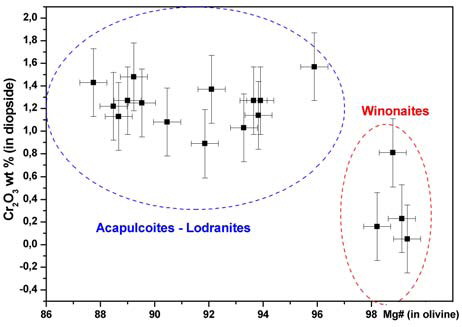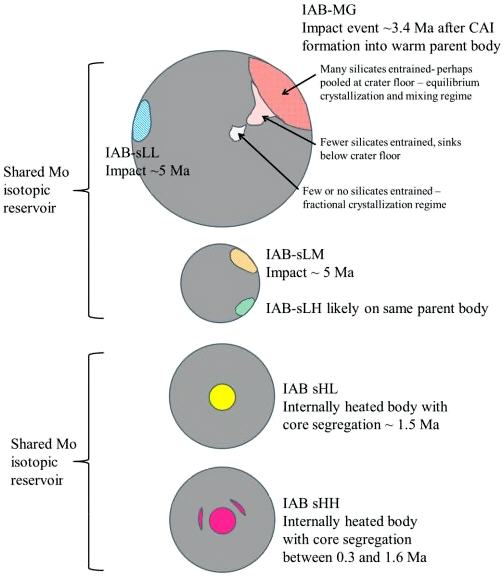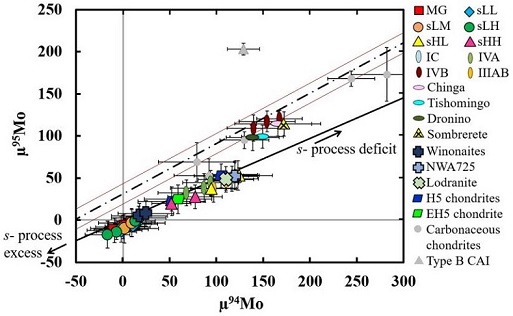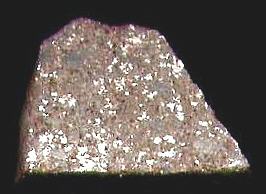NWA 1058
ChondriteChondrites are the most common meteorites accounting for ~84% of falls. Chondrites are comprised mostly of Fe- and Mg-bearing silicate minerals (found in both chondrules and fine grained matrix), reduced Fe/Ni metal (found in various states like large blebs, small grains and/or even chondrule rims), and various refractory inclusions (such Click on Term to Read More, ungroupedModifying term used to describe meteorites that are mineralogically and/or chemically unique and defy classification into the group or sub-group they most closely resemble. Some examples include Ungrouped Achondrite (achondrite-ung), Ungrouped Chondrite (chondrite-ung), Ungrouped Iron (iron-ung), and Ungrouped Carbonaceous (C-ung). Click on Term to Read More (type 5+)
previously AchondriteAn achondrite is a type of stony meteorite whose precursor was of chondritic origin and experienced metamorphic and igneous processes. They have a planetary or differentiated asteroidal origin where the chondritic parent body reached a sufficient size that through heating due to radioactive decay of 26Al (aluminum isotope) and gravitational Click on Term to Read More, ungrouped
originally Primitive AchondriteAchondrite with an almost chondritic composition with age similar to the primordial chondrites. These should be better classified as "metachondrites". (MetBull 87)
Purchased 2001
no coordinates recorded A 180 g stone was purchased in Erfoud, Morocco and subsequently sold to a meteoriteWork in progress. A solid natural object reaching a planet’s surface from interplanetary space. Solid portion of a meteoroid that survives its fall to Earth, or some other body. Meteorites are classified as stony meteorites, iron meteorites, and stony-iron meteorites. These groups are further divided according to their mineralogy and Click on Term to Read More dealer. The meteorite was submitted to the Institut für Planetologie in Münster and given the designation NWA 1058. Although initially considered to be an acapulcoitePrimitive achondrite that belongs to a small group named after the Acapulco meteorite that was observed to fall in Mexico in 1976. Acapulcoites are made mostly of fine-grained olivine (Fo3-14), orthopyroxene(En86-97), Ca-rich pyroxene (En51Wo44), plagioclase (An12-31), Ni-Fe metal, and troilite. They are transitional between primordial chondritic matter and more differentiated Click on Term to Read More, NWA 1058 was classified in a broad terminology as a primitive achondrite by Russell et al. (2003) due to its anomalous O-isotopic composition. On an O-isotope plot it falls on the terrestrial fractionationConcentration or separation of one mineral, element, or isotope from an initially homogeneous system. Fractionation can occur as a mass-dependent or mass-independent process. Click on Term to Read More line similar to the winonaites, but with O-isotopes that are more 16O-rich than most winonaites.
 Moggi-Cecchi et al (2011) also published a diagram showing the reductionOxidation and reduction together are called redox (reduction and oxidation) and generally characterized by the transfer of electrons between chemical species, like molecules, atoms or ions, where one species undergoes oxidation, a loss of electrons, while another species undergoes reduction, a gain of electrons. This transfer of electrons between reactants Click on Term to Read More state of the samples (Fe# in orthopyroxeneOrthorhombic, low-Ca pyroxene common in chondrites. Its compositional range runs from all Mg-rich enstatite, MgSiO3 to Fe-rich ferrosilite, FeSiO3. These end-members form an almost complete solid solution where Mg2+ substitutes for Fe2+ up to about 90 mol. % and Ca substitutes no more than ~5 mol. % (higher Ca2+ contents occur Click on Term to Read More vs. Mg# of olivine), and it distinguishes three separate clusters: the acapulcoites, lodranites, and winonaites. To that end, Irving et al. (2005) described NWA 1058 as a metamorphosed chondrite probably representing the regolithMixture of unconsolidated rocky fragments, soil, dust and other fine granular particles blanketing the surface of a body lacking an atmosphere. Regolith is the product of "gardening" by repeated meteorite impacts, and thermal processes (such as repeated heating and cooling cycles). Click on Term to Read More of the winonaite parent body. Furthermore, they argued that the occurrence of distinct chondrules precludes the use of the term achondrite to describe this meteorite, and suggest that the term metachondriteTerm used to describe a metamorphosed chondrite. Also referred to as a type 7 chondrite. Metachondrites are texturally evolved rocks derived from chondritic precursors and some have been classified as primitive achondrites. Click on Term to Read More or ‘W chondrite’ would be a more appropriate term to describe this texturally-evolved meteorite pairing group (Irving et al., 2005; Irving and Rumble III, 69th MetSoc #5288 [2006]).
New analyses were conducted by Worsham et al. (2017) for IAB complex irons, along with two winonaites (Winona and HaH 193), a lodranite (GRA 95209), the primitive achondrite NWA 725 (considered a pairing to NWA 1058), and other selected meteorite groups. Employing precise Mo, W, and Os isotopeOne of two or more atoms with the same atomic number (Z), but different mass (A). For example, hydrogen has three isotopes: 1H, 2H (deuterium), and 3H (tritium). Different isotopes of a given element have different numbers of neutrons in the nucleus. Click on Term to Read More data along with HSE and other literature data, they ascertained that the IAB complex irons represent at least three distinct parent bodies and at least three impact-generated metal–silicateThe most abundant group of minerals in Earth's crust, the structure of silicates are dominated by the silica tetrahedron, SiO44-, with metal ions occurring between tetrahedra). The mesodesmic bonds of the silicon tetrahedron allow extensive polymerization and silicates are classified according to the amount of linking that occurs between the segregation events (see top schematic diagram below). Moreover, they ascertained that the Mo isotope data, as well as the chemical and mineralogical data, attest to a common parent body for the winonaites and the MG/sLL irons. Importantly, they demonstrated that the Mo isotope values of NWA 725 do not plot with the IAB MG/sLL/winonaites, and that the values are all higher than those of the lodranite in their study. Notably, the Mo isotope values of NWA 725 plot within the field of the magmatic sHL and sHH irons, which are not genetically related to the other IAB parent bodies (see bottom diagram below). OxygenElement that makes up 20.95 vol. % of the Earth's atmosphere at ground level, 89 wt. % of seawater and 46.6 wt. % (94 vol. %) of Earth's crust. It appears to be the third most abundant element in the universe (after H and He), but has an abundance only Click on Term to Read More isotope data for the sHL and sHH irons could help resolve whether any potential genetic relationship exists with the NWA 725 pairing group.
Moggi-Cecchi et al (2011) also published a diagram showing the reductionOxidation and reduction together are called redox (reduction and oxidation) and generally characterized by the transfer of electrons between chemical species, like molecules, atoms or ions, where one species undergoes oxidation, a loss of electrons, while another species undergoes reduction, a gain of electrons. This transfer of electrons between reactants Click on Term to Read More state of the samples (Fe# in orthopyroxeneOrthorhombic, low-Ca pyroxene common in chondrites. Its compositional range runs from all Mg-rich enstatite, MgSiO3 to Fe-rich ferrosilite, FeSiO3. These end-members form an almost complete solid solution where Mg2+ substitutes for Fe2+ up to about 90 mol. % and Ca substitutes no more than ~5 mol. % (higher Ca2+ contents occur Click on Term to Read More vs. Mg# of olivine), and it distinguishes three separate clusters: the acapulcoites, lodranites, and winonaites. To that end, Irving et al. (2005) described NWA 1058 as a metamorphosed chondrite probably representing the regolithMixture of unconsolidated rocky fragments, soil, dust and other fine granular particles blanketing the surface of a body lacking an atmosphere. Regolith is the product of "gardening" by repeated meteorite impacts, and thermal processes (such as repeated heating and cooling cycles). Click on Term to Read More of the winonaite parent body. Furthermore, they argued that the occurrence of distinct chondrules precludes the use of the term achondrite to describe this meteorite, and suggest that the term metachondriteTerm used to describe a metamorphosed chondrite. Also referred to as a type 7 chondrite. Metachondrites are texturally evolved rocks derived from chondritic precursors and some have been classified as primitive achondrites. Click on Term to Read More or ‘W chondrite’ would be a more appropriate term to describe this texturally-evolved meteorite pairing group (Irving et al., 2005; Irving and Rumble III, 69th MetSoc #5288 [2006]).
New analyses were conducted by Worsham et al. (2017) for IAB complex irons, along with two winonaites (Winona and HaH 193), a lodranite (GRA 95209), the primitive achondrite NWA 725 (considered a pairing to NWA 1058), and other selected meteorite groups. Employing precise Mo, W, and Os isotopeOne of two or more atoms with the same atomic number (Z), but different mass (A). For example, hydrogen has three isotopes: 1H, 2H (deuterium), and 3H (tritium). Different isotopes of a given element have different numbers of neutrons in the nucleus. Click on Term to Read More data along with HSE and other literature data, they ascertained that the IAB complex irons represent at least three distinct parent bodies and at least three impact-generated metal–silicateThe most abundant group of minerals in Earth's crust, the structure of silicates are dominated by the silica tetrahedron, SiO44-, with metal ions occurring between tetrahedra). The mesodesmic bonds of the silicon tetrahedron allow extensive polymerization and silicates are classified according to the amount of linking that occurs between the segregation events (see top schematic diagram below). Moreover, they ascertained that the Mo isotope data, as well as the chemical and mineralogical data, attest to a common parent body for the winonaites and the MG/sLL irons. Importantly, they demonstrated that the Mo isotope values of NWA 725 do not plot with the IAB MG/sLL/winonaites, and that the values are all higher than those of the lodranite in their study. Notably, the Mo isotope values of NWA 725 plot within the field of the magmatic sHL and sHH irons, which are not genetically related to the other IAB parent bodies (see bottom diagram below). OxygenElement that makes up 20.95 vol. % of the Earth's atmosphere at ground level, 89 wt. % of seawater and 46.6 wt. % (94 vol. %) of Earth's crust. It appears to be the third most abundant element in the universe (after H and He), but has an abundance only Click on Term to Read More isotope data for the sHL and sHH irons could help resolve whether any potential genetic relationship exists with the NWA 725 pairing group. 
CRE-corrected Mo Isotopic Compositions of Meteorite Groups
(µ notation denotes deviation from terrestrial standards in parts per million)

click on photo for a magnified view
‘Characterizing cosmochemical materials with genetic affinities to the Earth: Genetic and chronological diversity within the IAB iron meteoriteIron meteorites consist mostly of metallic iron alloyed with typically between ~5 to ~30 wt% nickel. The main metal phases are kamacite α-(Fe, Ni) and taenite y-(Fe, Ni). Based on their group classification, they may also contain a small weight percentage of one or more of the following minerals: • Click on Term to Read More complex’
(https://doi.org/10.1016/j.epsl.2017.02.044) There is convincing evidence that NWA 1058 is paired with NWA 725, NWA 1052, NWA 1054, and NWA 1463 (Irving and Rumble III, 2006); a further pairing was found in 2007 and designated NWA 4835 (T. Bunch, NAU). The partial slice of NWA 1058 shown above weighs 0.9 g.







